#Danish Bog
Explore tagged Tumblr posts
Text
He’s The Most Famous of Europe’s Bog Bodies. But Who Was Tollund Man?
Was He a Human Sacrifice? A criminal? Scientists are Still Piecing Together Details About the Life—and Death—of the Man Mummified in a Danish Bog Some 2,400 Years Ago.
— By Erin Blakemore | February 6, 2024

The Tollund Man was discovered in 1950 in the Bjældskovdal bog in Jutland, Denmark. His mummified body was found in a sleeping position with a leather cord around his neck—and scientists have been analyzing his remarkably well-preserved remains ever since. Photograph By Robert Clark, National Geographic Image Collection
When a family cutting peat for fuel unearthed a mysterious body in a Danish bog in 1950, they assumed the well-preserved corpse was a local murderer’s latest victim. In fact, he was anything but: Although the man had been killed, his body dated from the Iron Age about 2,400 years ago.
Now known only as the Tollund Man, his incredibly preserved face, stubbled and slightly smiling, has ensured him a place as one of the world’s most famous bog bodies—made even more mysterious by the fact he was the assumed victim of human sacrifice.
In the decades since his discovery, scientists have studied Tollund Man extensively and pieced together more details about his life and death. Here’s what to know about the naturally mummified man.
Who Was Tollund Man?
A brown, bronze like mummified body of a man laying on his side in the fetal position on a square pile of brown earth and soil, with a braided rope around his neck against a black background.

Although Scientists know that Tollund Man died of hanging, they're not yet sure why. Could he have been killed in vengeance—or as part of a Ritual Sacrifice Photograph By Ian Dagnall, Alamy Stock Photo
The presence of wisdom teeth suggest the Tollund Man was at least 20 years old when he died in Denmark’s Bjældskovdal bog in Jutland, but researchers think he was actually between 30 and 40. Radiocarbon dating indicates he died at some point between 405 and 380 B.C.
Standing at about 5 foot 3 inches, the Tollund Man was discovered in a sleeping position with a rope around his neck. An autopsy revealed he had died of hanging, noting his extremely well preserved head and face.
After his death, the acidity in the peat bog preserved Tollund Man’s bones and many of his soft tissues, including an intact yet shrunken brain and intestines complete with their contents. Tollund Man’s skin and nails had cured and blackened over thousands of years spent in the oxygen-free environment of the bog. But their full decomposition was blocked by the chemicals that are produced when sphagnum moss, the main moss that comprises peat, degrades.
Today, his body is preserved at the Silkeborg Museum, a Danish cultural heritage museum near the place of his discovery.
Who Were His People?
Tollund Man lived during the early part of the Iron Age in the years before Rome conquered the majority of Europe. During the period, Jutland was well populated and home to villages and farms. The era’s farmers grew grain, kept animals, and engaged in religious rituals that involved leaving sacrifices—often food or weapons, but sometimes human bodies—in the local bogs.
Modern-day researchers suspect these bogs were seen as supernatural sites with connections to the gods and the afterlife. But since the Jutland dwellers left no writing behind, it’s unclear what actually drove their religious rituals.

Tollund Man was found in this bog in Denmark. What makes bogs so good at preserving bodies? Archaeologist Isabella Mulhall told National Geographic in 2023 that factors include the lack of oxygen, the acidity levels, and moss found in bogs that blocks the decomposition process. Photograph By Robert Clark, National Geographic Image Collection
What He Wore
Bogs are famous for preserving clothing along with bodies, like the knitted clothing that surrounded a Scottish bog body found in 1951. But Tolland man wore much less apparel: He was buried naked, clad only in a cap and belt.
Further investigations have revealed that Tollund Man likely wore shoes for part of the year, but also walked barefoot much of the time. Stubble on his face indicates he must have shaved.
His Last Meal
In 2021, researchers discovered the contents of Tollund Man’s last meal—porridge containing barley, a variety of wild seeds, flax, and fish. The gut analysis also revealed that unlike some other famous bog bodies, Tollund Man wasn’t under the influence of edible hallucinogens or other medicinal plants when he died—signs that typically indicate a human sacrifice.

His Death
But scientists say Tollund Man could have been the victim of a ritual sacrifice. The wide variety of types of seeds and weeds found in his gut are similar to those discovered in the digestive tracts of other bog bodies thought to have been sacrificed.
“People have suggested that they’re forming a human sacrifice because something’s going wrong in the environment,” archaeologist Henry Chapman said of those victims in a 2021 interview with National Geographic. Those cases have led researchers to believe that the sacrifices involved eating a wide variety of types of food before death, perhaps in response to environmental changes that threatened farming or food sources.
Another possibility is that Tollund Man’s death could have been more sinister: Perhaps he was a criminal or died by suicide, or was part of a vengeance killing thought to have been a practice in northern Europe at the time. Other bog bodies found throughout the region show evidence of purposeful killing and even gruesome abuses of the corpses.
But though he was clearly killed on purpose, Tollund Man’s body was also carefully buried, and his mouth and eyes closed. Ultimately, that careful burial, his hanging, and the fact that cremation and grave burials were more common at the time than throwing bodies into bogs is why many researchers do believe his death was part of some kind of sacred sacrifice.
His Remaining Mysteries
Though it’s been nearly 75 years since his discovery, Tollund Man could continue to yield more information to curious archaeologists. During scientists’ initial experiments with the bog body, his head was carefully preserved and was put on display in Denmark. But his body dried out and was misplaced—yes, misplaced.
For decades no one knew where the bog body’s limbs and organs were. This led to a bizarre treasure hunt in the 1980s, when researchers armed with new technologies realized the potential worth of the rest of the body and asked for the public’s help locating the remainder of the corpse.

Commonly found in bogs, sphagnum moss releases an acidic sugary molecule that takes up the nutrients that would otherwise nourish microbes that cause decay. This helps mummify corpses—though sphagnan also leaches the calcium out of bones, weakening them. Photograph By Robert Clark, National Geographic Image Collection
It turned out that the severed parts had been housed at a variety of museums and institutions throughout Denmark. The hunt yielded everything except for the internal organs and the bog body’s right big toe, whose location remained a mystery until the children of the former conservator returned it to the museum after their father’s death.
“Now nearly all body parts are in the museum[’]s possession,” the Silkeborg Museum says on its website. “Should anyone, however, come across a mysterious jar containing what might [be] his internal organs, we would be most interested to hear from you.”

The Tollund Man's thumb was among the appendages that were amazingly well preserved after thousands of years in the peat bog, a natural medium for mummification. Photograph By Robert Clark, National Geographic Image Collection
These remains could still produce more insights, though researchers have so far been unsuccessful at obtaining ancient DNA from Tollund Man’s tissues.
In the meantime, the bog man has inspired everything from poems to music to children’s books—a testament to the ongoing fascination he invokes in both scientists and the public. “He is not merely a museum piece, but a man,” one archaeologist told The Age in 1956. “We refuse to believe in his death. There is a living man behind the warmth and fine humor of his face.”
#Europe#Denmark 🇩🇰#Bog Bodies#Tollund Man#Human Sacrifice#Crime?#Criminal?#Scientists#Details#Life & Death ☠️ 💀#Danish Bog#Mummies#Mummified#Mummification#Jutland Peninsula | Denmark 🇩🇰#Bjældskovdal Bog#Ritual Sacrifices#Iron Age#Rome | Italy 🇮🇹#Archaeologist | Isabella Mulhall
1 note
·
View note
Text



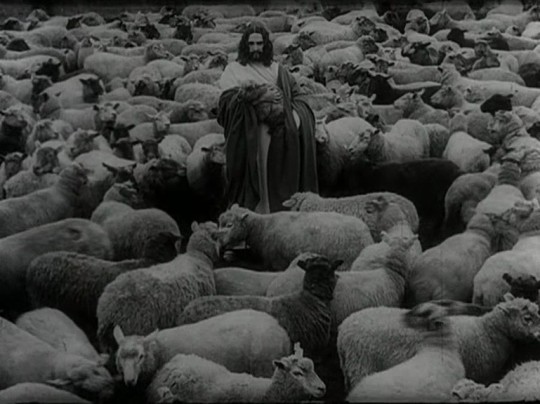
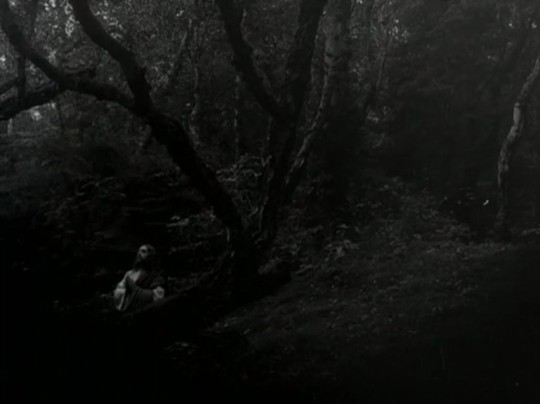
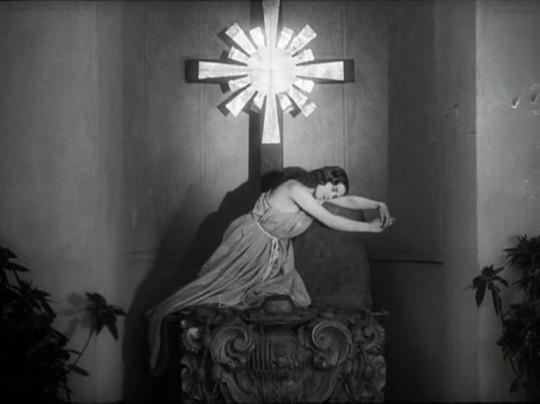


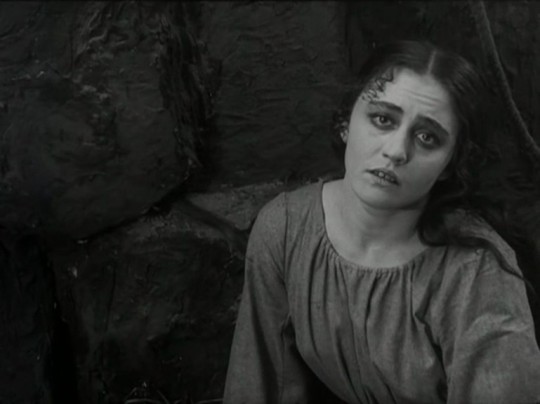

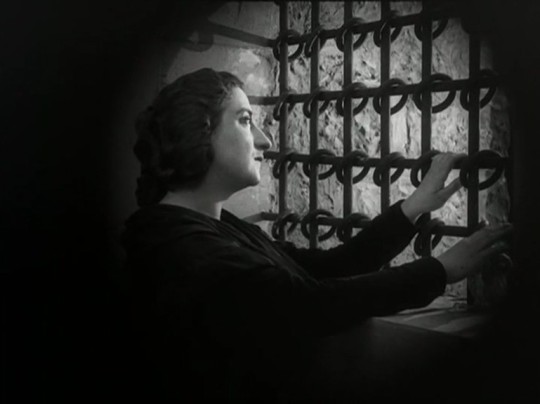
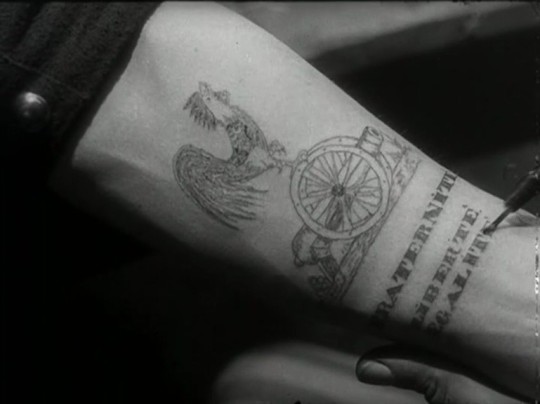
Blade af Satans bog (Carl Theodor Dreyer, 1919)
#Blade af Satans bog#carl theodor dreyer#1919#danish movie#danish cinema#danish films#silent#silent cinema#silent movies#silent film#cross#window#jesus christ#sheep#harp
20 notes
·
View notes
Text
minecraft mod where you throw villagers into the swamp biome and a few days later you go collect iron
1 note
·
View note
Text
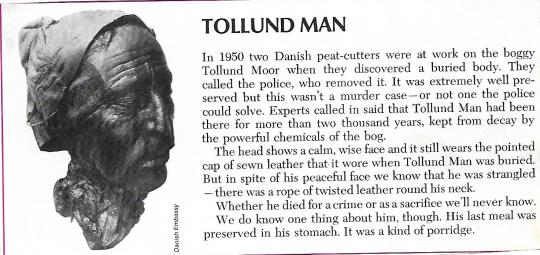
1 note
·
View note
Text
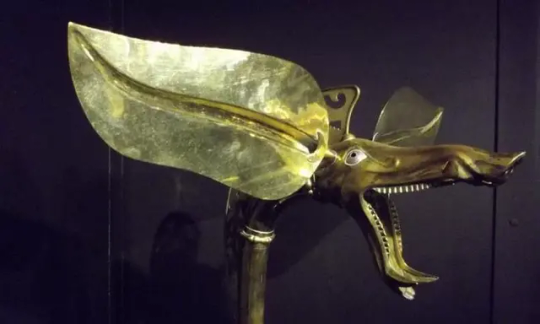
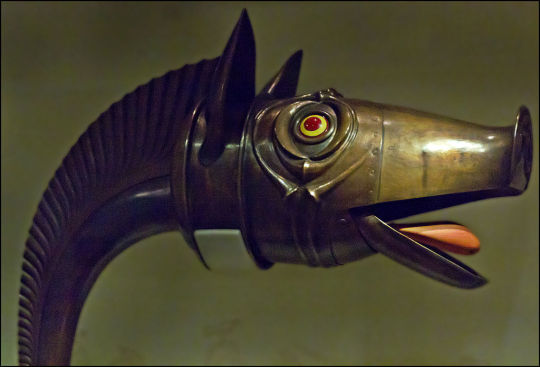
The 'Carnyx' Nightmare of the Roman Soldiers
The Carnyx was a brass musical instrument used as a psychological weapon of war by the ancient Celts between 300 BC and 200AD in western and central Europe and beyond.
The carnyx was once widespread throughout much of Europe, although only a dozen or so fragments are known to us.
It was carried by bands of Celtic mercenaries; it was present at the attack on the Greek sanctuary at Delphi in 279 BC; it defied Julius Caesar in Gaul; and it faced Claudius when he invaded Britain. They are even shown on a Buddhist sculpture in India, proof of the far-flung connections of the Iron Age world.
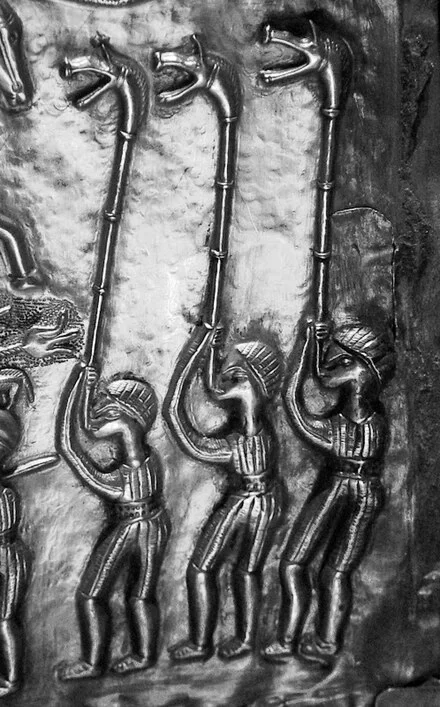
However, they were not only used by the Celts; they were also used by the Dacians in modern Romania. The term “Celtic” is a complicated one. The concept of a pan-European Celtic culture is a myth; rather, aspects of art and technology were shared across vast distances by diverse cultures. The carnyx was one example of this.
A 12-foot-long, thin bronze tube with right-angle bends on both ends made up the carnyx. The lower end ended in a mouthpiece, and the upper end flared out into a bell that was usually decorated to look like a wild boar’s had. Historians believe it had a tongue that flapped up and down, increasing the noise made by the instrument. The carnyx was played upright so that the boar’s head bell protruded well above the warriors’ heads. Its primary goal was to create more noise and confusion on the battlefield.
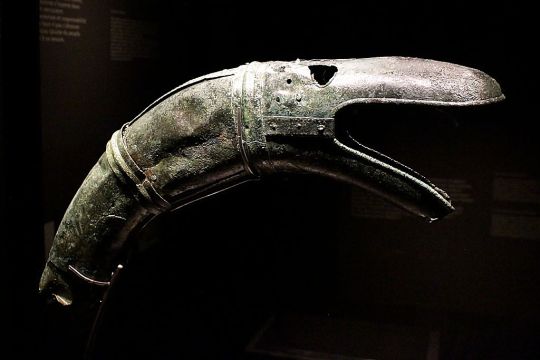
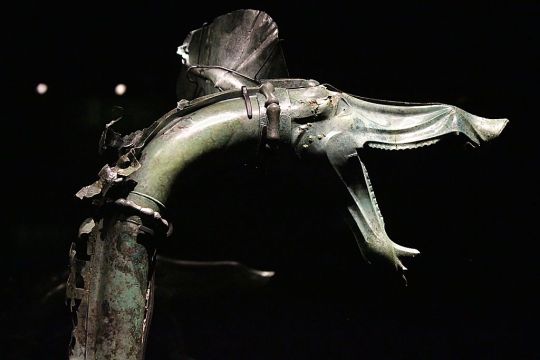
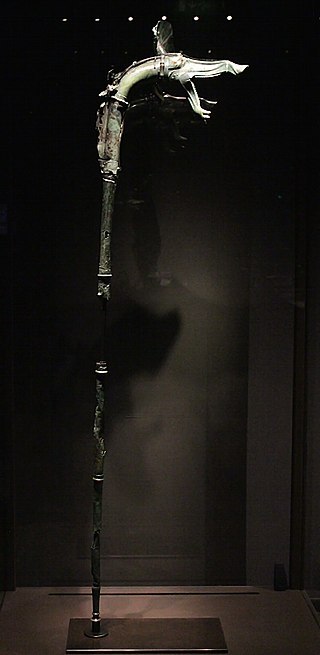
The Greek historian Polybius (206-126BC) was so impressed by the clamor of the Gallic army and the sound of the carnyx, he observed that “there were countless trumpeters and horn blowers and since the whole army was shouting its war cries at the same time there was such a confused sound that the noise seemed to come not only from the trumpeters and the soldiers but also from the countryside which was joining in the echo”.
And the Roman historian Diodorus Siculus wrote, “Their trumpets are also of a peculiar and barbaric kind which produce a harsh, reverberating sound suitable to the confusion of battle.”
Archaeologists discovered a hoard of ritually destroyed weapons in 2004, including a dozen swords, scabbards, spearheads, a shield, bronze helmets, an iron helmet shaped like a swan, a cauldron, animal remains, and seven carnyces. Before the Tintignac discovery, the remains of only five actual carnyces had been found.
The finest was unearthed in Deskford, Scotland in 1816. The Deskford carnyx only has the boar’s head bell and is missing the mane, tongue, and tubing. Images of Carnyx players have been found as well. A Roman denarius, dating from 48 BC bears a representation of a Carnyx. Three carnyx players are featured prominently on the Gundestrup Cauldron, which was found in a Danish peat bog.
One of the seven found at Tintignac, on the other hand, was almost entirely complete. The Tintignac Carnyx was broken into 40 pieces. When puzzled back together, it was found to be just an inch short of six feet long with a single missing section of the tube. The bell was a boar’s head with protruding tusks and large pointed ears. Once restored, the Tintignac Carnyx proved to be the first virtually complete carnyx ever found.
By Leman Altuntaş.
Music video by John Kenny.
#The Carnyx#The 'Carnyx' Nightmare of the Roman Soldiers#Iron Age war trumpet#ancient artifacts#archeology#archeolgst#history#history news#ancient culture#ancient civilizations#celtic mythology#celtic history#roman history#roman empire#roman legion
3K notes
·
View notes
Text
the urge to get a taupe cat and name it buckwheat is so strong
the urge to get an orange cat and name it cheddar is so strong
#no but seriously#i wanna call my next pet boghvede ( <- danish word for buckwheat)#nickname them bog which means book 📖#• comfort if you need it •
6 notes
·
View notes
Text


Very rare finds 🔥🔥🔥
1. ⚔️ Ritually bent Bronze Age sword discovered in Danish bog
The archaeologists suggest that the sword is a physical representation of the transition between the Bronze and Iron Ages, as the sword itself is made from bronze while the handle has iron rivets. This indicates that the deposit dates from around 500 BC.
And the sword's design suggests it was not made in Denmark but rather in more southern parts of Europe that were dominated by the Hallstatt culture during the Bronze Age. The Hallstatt culture thrived from about the 8th to the 6th centuries B.C. and was influenced by Europe's early Celtic culture.
Before the sword was sacrificed, it has been ritually bent to make it unusable as a weapon, although this practice was no longer common at that time.
Source: Heritage Daily, Live Science
2. ⚔️ Rare Viking-Era Sword Resurfaces After a Thousand Years in a Polish river
It's happened in 2022, when an employee of the Military Museum in Białystok discovered the artifact in Poland’s Supraśl River, but the restoration was only completed now. The restored sword has mineralized fragments.
Experts believe the sword was forged in the late 9th or early 10th century, potentially linked to Viking or Baltic cultures. The weapon’s design, marked by its distinctive hilt, aligns with Viking craftsmanship but also hints at possible influences from Baltic communities.
Experts believe the sword was either lost during a river crossing or left behind after a skirmish.
- -
Очень редкие находки 🔥🔥🔥
1. ⚔️ В Дании нашли необычный ритуальный меч бронзового века
Найденный артефакт является уникальным примером древних верований и ритуалов. По словам археолога Эмиля Винтера Струве, изгиб сделал меч непригодным для использования в качестве оружия.
Меч свидетельствует о переходном периоде между бронзовым и железным веками: его лезвие изготовлено из бронзы, а рукоять имеет железные заклепки. Это указывает на то, что месторождение датируется примерно 500 г. до н.э.
Дизайн меча предполагает, что он был изготовлен не в Дании, а в более южных частях Европы, где в бронзовом веке доминировала Гальштатская культура. Она процветала примерно с VIII по VI вв. до н.э. и находилась под влиянием ранней кельтской культуры Европы.
Ресурсы: Heritage Daily, Live Science, naukatv.ru,
2. ⚔️ Меч каролингского типа с кожаной обмоткой найден в Польше
Еще летом 2022 года сотрудник Музея армии в Белостоке обнаружил артефакт в реке Супрасль, но реставрация завершилась только сейчас. Отреставрированный меч имеет минерализованные фрагменты.
Согласно типологии Петерсена, являющейся общепризнанной классификацией европейских мечей и созданной в первой четверти XX века, меч относитс�� к типу E. Датирование находки охватывает период конца IX – начала X века, что делает ее ценным историческим артефактом. Вероятно, oрyжиe связано с культурой викингов или балтийских народов.
Эксперты полагают, что меч был либо утерян во время переправы через реку, либо оставлен после стычки.
#Viking #Sword #меч #викинги #archeology #археология
22 notes
·
View notes
Text
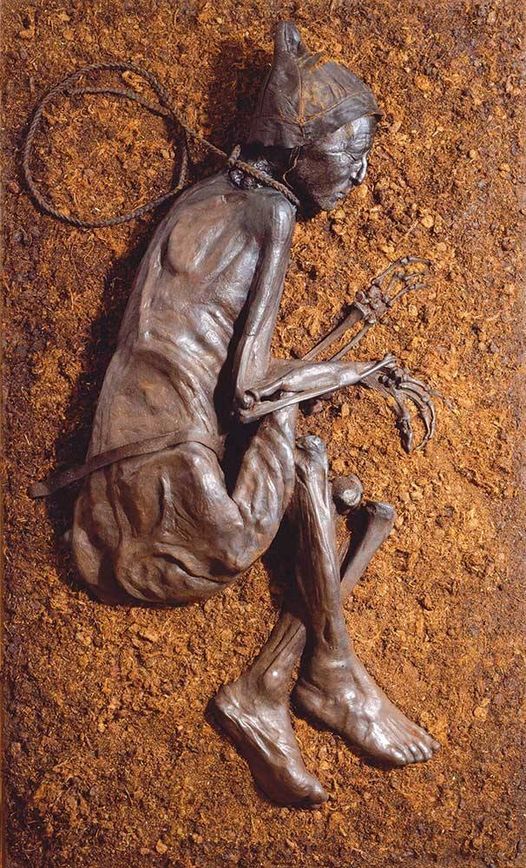
The Tollund Man (also Tollundmann; Danish Tollundmanden) is a bog body discovered by peat cutters on 8 May 1950 in a raised bog in Bjældskovdal, ten kilometres west of Silkeborg, Denmark. He is now on display in the ‘Hovedgården’ museum in Silkeborg.
The Tollund man was lying in a relaxed position on his right side, his legs drawn up to his stomach. With the exception of a sheepskin cap sewn together from eight pieces and a 77 cm long leather belt, he wore no clothing. It is possible that he was originally clothed in textiles made from plant fibres such as flax, hemp or nettles, which were decomposed by the acidic environment of the bog. He was estimated to be around 40 years old. At 161 cm, he was rather short, but probably also shrunk in the bog so that his skin lay in folds. His arms and hands had been damaged during peat cutting, but his feet and one of his fingers were well preserved. The papillary lines and skin line patterns on the soles of the feet were no different from those of modern humans.
The head was particularly well preserved. The facial expression was calm, mouth and eyes closed, and gave the impression of a sleeping person. He appeared well groomed. His hair was cut short and 2 to 3 cm long. The leather cap covering his scalp was fastened with two leather strips under his chin. The neck of the bog body was in a plaited leather sling, which had left clear marks in the skin on the sides and under the chin. The free end of the strap under the corpse was about a metre long and had been cut off at the end. Most of the upper body was still covered in skin. However, the left side of the chest and shoulder in particular were poorly preserved and partially decomposed. The genitals were well preserved, as were the internal organs such as the heart, lungs and liver. The stomach, small intestine and large intestine of the Tollund man still contained the remains of his last meal.
The noose still around his neck suggests that Tollund Man died violently by strangulation, although the doctor who carried out the forensic examination was certain that the man had not been strangled but hanged. The way he was laid in the bog - in a sleeping position with his eyes closed - suggests that he was not killed by enemies. It is likely that it was a human sacrifice, perhaps in gratitude for the peat or in winter as a plea for the coming spring. His death is dated to 405-380 BC.
61 notes
·
View notes
Note
I’ve never heard of ScotNor before, is there any historical background for the ship? Just curious, they’re a cute couple!
The historical background is a large part of what makes a ship interesting to me, and ScotNor’s history is definitely of great appeal along with their peoples and culture. I’ve touched upon this topic before, but that was probably years ago now, so we’re due for a bit of a refresher! Thanks for the interest 🙏 I’m sure there’s no history I’ve not included in my time line below, but this a summary of what I’ve gathered so far.
Viking Period (→ 1066).
The earliest contact between the nations Norway and Scotland begins in the Viking Age and it presents itself in different manners. Norway is expanding across the islands in the Norwegian Sea and the North Atlantic and gain sovereignty over Shetland, Orkney, and the Hebrides among others. Note that this is almost exclusively Norwegian people – the Danes usually went to England and the Swedes went East. This increased the contact between the two nations, manifesting in settlement, integrating with the locals, and more trade. There were some disagreements and there is still several theories about how violent and early the colonisation of the Scottish islands were, but we find some evidence that their interactions remained mostly peaceful in the certain areas. Norwegian Vikings definitely fought against both Gaels and Picts before they joined forces.
The celtic name Laithlind/Lochlann, is thought to reference Scandinavia – mainly Norway, but might also be the word for the Norwegian areas of Scotland. The word means “land of bog/lakes” and could be related to the Welsh word for Scandinavia; Llychlyn
Norse Period (1066 – 1468).
The Norse Period is the name of a period in Scotland from the end of the Viking Age in the middle of the 11th century to 1468, when the Danish King gives away the last of Norway’s territories on the British Isles to the Scottish King as a dowry. During this period people in the Norwegian occupied areas identifies as Norse and their language evolve from Norse into Norn, which was in some places spoken until the 1800s.
The Battle of Largs was fought between Norway and Scotland in 1263 A battle at both sea and on land with no winner. They fought over the rights to the Western Isles, which the Scottish King had tried to buy since 1240, but had been rejected. The Norwegian King felt threatened and left Norway with a great fleet to negotiate/fight. After failed negotiations and some Norwegian raids a huge storm surprised the fleet and crashed some of the boats and washing them ashore where the crews were attacked by twice as many Scottish forces. The storm hindered any tactical moves as the waves and wind made it impossible to control the ships, but eventually the Norsemen got back on some of the ships and it became a long distance battle, which both sides pulled back from after a while. The Norwegian King died from illness in Orkney later that year and his son negotiated a treaty with the Scottish King where he gave up the islands for money and trading prospects with Scotland.
Margaret Maid of Norway, was the granddaughter of the Scottish King and the daughter of the Norwegian King. Her mother’s marriage to the King of Norway was diplomatic and a move to strengthen the relations between the countries. Her mother dies in childbirth and Margaret Maid of Norway suddenly become heir to the Scottish throne when her grandfather dies, but unfortunately she dies only 7 years old from illness on her way across the sea to claim her throne in 1290.
Originally, Norway was part of the Auld Alliance. With the negotiating skills of a Norwegian diplomat, Norway became part of the Auld Alliance in 1295, a military alliance that lasted until 1560. Norway was a member until 1326. The alliance marked the end to Norwegian expansion in the British Isles and cemented their collaboration. The Auld Alliance said that if one of the parties was attacked by England, the others should help. Norway were to supply Scotland with warships while England and France were at war, but Scotland never paid and Norway never sent any ships as they were still hesitant to make an enemy out of England. It’s seen as a bit of a scam on Norway’s part as they accepted a pre-payment for their help, but the money “disappeared” and Norway would never have been able to provide the amount of ships and warriors they promised.
Then Norway becomes a part of the Kalmar union as a result of the devastating effect the Black Death in 1348 had on the Norwegian Elite, leaving Norway weak and under Danish rule for about 400 years, where the Danish king in 1468 gives away Orkney and Shetland as a pawn for the dowry of his daughter because he did not have the money to pay (this situation was never actually resolved and the isles still could be considered only a pawn).
Norway under Denmark and Scotland under England (1397 – 1814).
Norway entered a union with Denmark and Sweden in 1397 and proceeded to fall further under Denmark’s rule for about 400 years until 1814, while Scotland entered a union of crowns with England in 1603 and then later a personal union in 1707, which still stands. During these periods it is difficult to talk about the interactions of the nations Norway and Scotland as they both fall in the shadow of the more powerful nation running the union, Norwegians often just considered Danes by people from other countries at this time.
The Battle of Kringen in 1612 was a battle between invading Scottish mercenaries hired by the Swedes, and Norwegian farmers. Denmark-Norway was at war with Sweden again and the Swedes had employed help by foreign forces – very common at this time, and Scottish mercenaries were famous. The Scottish forces were to meet up with Swedish forces, and while they traversed the country they robbed and pillaged Norwegian farms. Norwegian farmers organized and staged an ambush on Scots as they passed through steep terrain, trapping them by cutting trees and disrupting them by rolling rocks down the mountainside. They were only armed with spears, axes and scythes, but managed to absolutely devastate the Scottish army. The Norwegian farmers only suffered 6 deaths while the Scots only had 18 out of 300 make it out alive in the end.
The 1800s.
In the 1800s, Norway was become its own country (still in a union with Sweden) and it’s at this time tourism in the country becomes popular in Great Britain, with both Scottish and English Lords travelling to Norway to fish salmon and hunt and experience the nature. In 1886 a Scottish shipping company began to provide Norwegian cruises to look at the fjords along the coast of Norway, maybe one of the first ever boat cruises, which was so popular that they increased the amount of ships the following year. This continued until World War One began.
In 1806 a Norwegian son of a wealthy merchant travelled with one of their trading ships to the Caribbean, but the ship sank by Jamaica. He drifted on the shipwreck for three days before he was rescued by a British ship. The officer who took care of him was son of a wealthy Scottish landowner, and they became enamoured with each other and never left the other’s side after this. They spent the rest of their lives together, travelling between their estates in Norway, their castle in Scotland, and apartments in London, Paris, Rome, and Naples.
Skotthyll is a game that used to be prevalent in my region, and it’s said to be a game invented by Scottish engineers who came to Norway to work on a railroad in the 1860s.
The 1900s.
When Norway became independent from Sweden in 1905, the new king received a letter from the authorities on Shetland stating that “today no ‘foreign’ flag is more familiar or more welcome in our voes and havens than that of Norway, and Shetlanders continue to look upon Norway as their mother-land, and recall with pride and affection the time when their forefathers were under the rule of the Kings of Norway”.
During the First World War, Norway was neutral, but very much involved with the ongoing politics as they wanted to keep trading with both sides, but eventually settled for Great Britain when they decided to commit to buying all the fish Germany normally would have bought. When the Germans began sinking Norwegian ships, it also drove them further onto the side of Great Britain.
During the Second World War Norway was occupied by Germany, and many of those who fled went to Great Britain (as was the case with most of Europe). On Shetland, there was established a Norwegian base of operations where Norwegian sailors and volunteers would carry out missions across the North Sea to Norway. There they would smuggle in weapons and provisions and information to the resistance, as well as helping refugees to escape the country. This was of immense help to Norway during the war. Additionally, a training camp for Norwegians was established in the Scottish highlands, where Norwegians who wanted to fight for their country was stationed and trained for missions by the Allies.

#historical hetalia#hetalia#scotnor#aph norway#aph scotland#hws norway#hws scotland#thanks for the ask! Always love talking about them - thanks for taking an interest 💖 they're the best ship I promise#long post#so glad I had written about this before - this took a lot longer than expected to put together
42 notes
·
View notes
Text

Thanks to @larkral & @rimeswithpurple for the tags ❤️
I’ve been in a weird space lately and still figuring out my life. It’s a time. Grateful to everyone who keeps tagging me even when I don’t have the emotional bandwidth to engage. Know I’m rooting for all of your projects and lives even when I’m quiet.
Trying to find fun I hopped over to a new fandom where I’m writing a smut fic I can’t believe doesn’t already exist. You mean a character canonically went four weeks without jacking off and no one made a UST fic about it?!?!?! No guarantees on if I actually finish this but here’s what I’ve got to start:
Five weeks. It’s been five weeks since Buck last boxed the one-eyed champ and, despite barely missing the nine o’clock cut-off from his last donation appointment, he’s been doing fine. Just fine, in fact. One might even say great.
Who needs that kind of release when you’re doing something good for a friend? For the world?
Buck feels enlightened. Saintly. In fact, he’s tempted to repeat this as a seasonal cleanse. LA’s real big into cleanses.
“If you wipe that counter any harder you’ll put a hole in it,” Hen stage-whispers as she passes behind Buck to pick up another pastry, “unless that’s the point?” She waggles her eyebrows for emphasis as she bites into a danish.
“Not so—” Buck clears his throat and looks side-to-side. He lowers his voice, “Not so loud, Hen. Come on.”
“What is ‘something I can do but Buck can’t’ for the win, Mr. Jennings.”
Yes I had to google the current host of Jeopardy for this fic. And the Santa Ana winds. And other things.
Me: I’m gonna write a silly little smut to recapture the joy of writing.
Also me: bogs it down in boring things like facts.
Tagging the besties I’ve subjected to my 9-1-1 hyperfixation: @thewholelemon & @raenestee plus the OGs @martsonmars & @sillyunicorn and for shits and giggles @bookish-bogwitch welcome to my new hell I’m neglecting every other fic commitment 🤣 pls support me in my procrastination
25 notes
·
View notes
Text
I'm fascinated by the ritual destruction of weapons.
9 notes
·
View notes
Text
The Halloween 2024 roster so far: leaning pretty heavily on new and indie horror this year. I actually liked most of these to some degree or other. Lots of unexpected sci-fi but I'm not complaining.
The Company of Wolves - beautiful, dreamlike, features not one but two of the craziest werewolf transformations I've ever seen. Mr. X insists this is not a horror film, but it has an Angela Carter screenplay and werewolves, so I say it counts.
Deathstream - Horror comedy with a very convincing YouTube channel spending the night alone in a haunted house. Some legitimately funny bits here and good use of the premise.
Army of Darkness - I've heard the quotes for many years but I had never actually seen the movie until now. Bruce Campbell really should have been allowed to star in more films. I enjoyed every minute of this, allowing for the bog-standard 80s-90s misogyny.
Speak No Evil (Denmark) - I am not watching the US one if they changed the ending. The ending is the entire point. It's a commentary on Danish society and if you couldn't adapt that to the US then why are you remaking the movie? Stop wasting my time. Anyway this was great. Frustrating, but again, that's the point.
Happy Death Day - Better than expected. Groundhog's Day slasher, has fun with the premise. The actress sells it.
Happy Death Day 2 - The same but make it sci-fi.
Synchronic - Cool concept, which I don't want to spoil too much except to say it's about a convenience store drug with an unexpected side effect. A little lazy as a film but I enjoy watching Anthony Mackie do his thing.
Something in the Dirt - This film and the one before are from the guys who made Resolution and The Endless. Neither are as good as those but worth seeing if you liked their other films. This film is again a sci-fi scenario, sort of cross-polinated with William Friedkin's Bug.
Bodies Bodies Bodies - Takes the slasher theme of "insufferable youths die one at a time" to its natural conclusion. Perfect casting. Had a great time with this.
I Saw the TV Glow - Magical, haunting, endlessly sad. Still thinking about it.
Oddity - NO THANK YOU SCARY WOODEN DOLL. THIS MADE ME UNCOMFORTABLE.
Freaky - Another comedy horror, a body-swap where a teenage slasher victim swaps bodies with the killer. Resulting in Vince Vaughn portraying a teenage girl and taking it pretty seriously? Like he's all in? But I enjoyed the teenage girl serial killer even more.
Abigail - The trailer gives most of the plot away but it's still really fun and the ballet really adds to the action scenes. Cast is really good. Goes in a couple unexpected directions, one of which had me saying oh THAT'S why Dan Stevens is in this, now I understand.
Hold Your Breath - Kind of meh but the setting itself was engrossing, in the middle of the dustbowl farmlands. Sarah Paulson doing the most again.
She Will - Lowkey involving, though I've forgotten most of what happens.
Immaculate - Search your feelings. Are you willing to cheer on a priest being strangled by his own rosary? If so, watch this immediately. As a heathen I found it, as Glen Weldon would say, a hoot and a half.
Caddo Lake - Did you like Dark, the twisty and moody german tv show? This is the American version. I mean it's not but it very much is.
Ghostwatch - the legendary banned BBC broadcast, which you can now watch on Prime, is still pretty effective.
The Dark and the Wicked - This was trying waaaaaay too hard to be Hereditary. Didn't really enjoy it.
We Are All Going to the World's Fair - Mr. X slept through this but I was hypnotized by it. There are two kinds of people.
Maxxxine - Not as good as X or Pearl, and it if was a stand-alone film it would be pretty incoherent. But it is very stylish and has a lot of fun with the 80s LA setting, and I can watch Mia Goth do her thing all day long.
Suspiria - Legendary. Loved it. When did we stop using COLORS in movies?
Longlegs - this one at least remembers the color red, for the very striking opening. It runs out of steam a little bit throughout but pretty exciting for a lot of the run. Liked the probably-autistic protagonist a lot. There are some Nicolas Cagisms and I never for a moment forgot it was him, but he does have some genuinely frightening moments.
The Quatermass Experiment - Most of my favorite things were influenced by this so figured it was time to check it out. Glad I did. Fascinating and makes good use of its low budget. Free on Youtube!
Eyes Without a Face - I may have had some nightmares after this.
Glorious - Surprise, you got some cosmic horror in your rest stop bathroom freakout, and JK Simmons is here!
Next on the list is probably Possession which I fully anticipate is gonna fuck me up.
Top films so far? Suspiria, Eyes Without a Face, Longlegs, I Saw the TV Glow, Bodies Bodies Bodies
#halloween#horror#our agreement as a couple is that I will watch whatever horror films Mr. X puts in front of me in October#so long as he does not abuse that privilege with say Martyrs#after years of this I am much more open to the experience though I'm still not a big fan of gore
8 notes
·
View notes
Text

"Whether there have been big cats [in Denmark] is doubtful, unless they have been brought in from elsewhere, such as the case of 1630 in Vendsyssel, told by N. Slange in King Christian IV's "Historie," tome II, page 695. An imperial colonel had, in the recent wartime, brought back a pair of big cats, made them tame, and used them as his hunters; they were trained to go out and bring their prey back to him. The colonel lived in Sæby. The animals would hunt on their own, and did great damage, but caused even greater fear, since it was a male and a female. Finally the female was found frozen to death in Hammel Bog. The male was met by Junker Jacob Kruse in Dronninglund Forest, who saved his own life by shooting it."
From "Den Danske Atlas" [The Danish Atlas], book 1, page 607. Erik Pontoppidan (1763).
44 notes
·
View notes
Text
Words borrowed from other languages in English
Very incomplete list, based mostly on The Languages of the World (3rd ed.), Kenneth Katzner, 2002 + a heavy use of Wiktionary. some notes:
Many of these words have passed through multiple languages on their way to English (e.g. Persian -> Arabic -> Spanish -> French -> English); in that case I usually list them under the first language that used them with the same meaning as English.
I generally don't include words whose ancestors already existed in Middle English, unless their origin was exotic enough to be interesting.
The vast majority of borrowings are terms very specific to their culture of origin; I generally only include those that are either well known among English-speakers, or of general use outside that culture. As always, this is largely subjective.
INDO-EUROPEAN FAMILY (West and South Eurasia)
Hellenic
Greek: angel, chronometer, democracy, encyclopedia, geography, graphic, hieroglyphic, homogeneous, hydraulic, kudos, meter, microphone, microscope, monarchy, philosophy, phobia, photography, telephone, telescope, thermometer, and way too many other scientific or technical terms to count
Germanic
Afrikaans: aardvark, apartheid, fynbos, rooibos, springbok, trek, veld, wildebeest
Danish: Lego, simper
Dutch: brandy, bumpkin, coleslaw, cookie, deck, dock, dollar, freight, furlough, hodgepodge, landscape, maelstrom, noodle, Santa Claus, waffle, walrus, yacht
German: aurochs, bildungsroman, blitzkrieg, cobalt, dachsund, eigenvector, ersatz, gestalt, glockenspiel, hamburger, hinterland, kindergarten, kohlrabi, lager, poodle, quark, sauerkraut, wanderlust, yodel, zeitgeist
Icelandic: eider, geyser
Norwegian: auk, fjord, krill, lemming, narwhal, slalom, troll
Swedish: lek, mink, ombudsman, rutabaga, smorgasbord, tungsten
Yiddish: bupkis, chutzpah, kvetch, putz, schlemiel, schmaltz, schmooze, schtick, spiel, tchotchke
Slavic
Czech: robot
Russian: fedora, glasnost, intelligentsia, kefir, mammoth, pogrom, samizdat, steppe, sputnik, troika, tsar, vodka
Serbo-Croat: cravat, paprika
Celtic [many of these words are shared between the two languages]
Irish: bog, galore, gaol, geas, glen, orrery, shamrock, slob, whiskey
Scottish Gaelic: bard, bunny, cairn, clan, loch, ptarmigan, ?scone, slogan
Italic-Romance
†Latin: way too many, but ignoring the ones that were already naturalized in Middle English: a priori, arcane, algae, alumni, artificial, calculus, cancer, carnivore, cavity, circa, confide, dire, federal, flammable, homicide, interregnum, larva, lemur, magnanimity, manuscript, millipede, nebula, nimbus, nocturnal, octave, optimal, postmortem, senile, supernova, urban, verbatim, and countless medical or legal terms
French: the bulk of French (or rather Norman) borrowings occurred before Middle English, but to stick to my rules: aubergine, bourgeois, buttress, camouflage, capitalism, caramel, chassis, chauvinism, cheque, collage, elite, embassy, ennui, espionage, etiquette, facade, fondue, gouache, guillotine, infantry, lingerie, mauve, mayonnaise, mollusk, Renaissance, reservoir, sabotage, souvenir, turquoise...
Italian: allegro, aria, balcony, bandit, bravo, calamari, casino, cello, chiaroscuro, crescendo, contraband, contrapposto, fresco, gazette, ghetto, gusto, inferno, lagoon, lava, mafia, malaria, pants, quarantine, tempo, umbrella, vendetta, volcano
Portuguese: baroque, brocade, cachalot, cobra, creole, flamingo, petunia, pimento, zebra
Spanish: abalone, armadillo, bolas, bonanza, canyon, cargo, chupacabra, cigar, cilantro, embargo, gaucho, guerrilla, junta, manta, mesa, mosquito, mustang, patio, pueblo, rodeo, siesta, tornado, vanilla
Iranian
Persian: bazaar, caravan, checkmate, chess, crimson, dervish, divan, jackal, jasmine, khaki, kiosk, lemon, lilac, musk, orange, pajama, paradise, satrap, shawl, taffeta
Indo-Aryan
†Sanskrit: brahmin, Buddha, chakra, guru, karma, mantra, opal, swastika, yoga
Bengali: dinghy, jute, nabob
Hindi: bandana, bungalow, cheetah, chintz, chutney, coolie, cot, dungaree, juggernaut, lacquer, loot, rajah, pundit, shampoo, tom-tom, thug, veranda
Marathi: mongoose
Romani: hanky-panky, pal, shiv
Sinhalese: anaconda, beriberi, serendipity, tourmaline
DRAVIDIAN FAMILY (Southern India)
Kannada: bamboo
Malayalam: atoll, calico, copra, jackfruit, mahogany, mango, pagoda, teak
Tamil: curry, mulligatawny, pariah
Telugu: bandicoot
URALIC FAMILY (Northern Eurasia)
Finnic
Finnish: sauna
Saami: tundra
Samoyedic
Nenets: parka
Ugric
Hungarian: biro, coach, goulash, hussar, puszta, tokay
VASCONIC FAMILY (Northern Pirenees)
Basque: chaparral, chimichurri, silhouette
TURKIC FAMILY (Central and Northern Eurasia)
†Old Turkic: cossack, yurt
Tatar: ?stramonium
Turkish: baklava, balaclava, bergamot, caftan, caviar, harem, janissary, kebab, kismet, minaret, pastrami, sherbet, tulip, yoghurt
Yakut: taiga
MONGOLIC FAMILY (Mongolia and surrounding areas)
Mongol: horde, khan, ?valerian
SINO-TIBETAN FAMILY (China and Southeast Asia)
Tibeto-Burman
Burmese: ?marzipan
Tibetan: lama, panda, tulpa, yak, yeti
Sinitic [Chinese languages closely related, not always clear from which a borrowing comes]
Hokkien: ?ketchup, sampan, tea
Mandarin: chi, dazibao, gung-ho, kaolin, oolong, shaolin, shanghai, tao, yin-yang
Min Nan: nunchaku
Yue (Cantonese): chop suey, dim sum, kowtow, kumquat, lychee, shar-pei, ?typhoon, wok
TUNGUSIC FAMILY (Eastern Siberia)
Evenki: pika, shaman
KOREANIC FAMILY (Koreas)
Korean: bulgogi, chaebol, hantavirus, kimchi, mukbang, taekwondo
JAPONIC FAMILY (Japan)
Japanese: banzai, bonsai, dojo, emoji, geisha, ginkgo, hikikomori, honcho, ikebana, kamikaze, karaoke, koi, kudzu, manga, origami, pachinko, rickshaw, sake, samurai, sensei, soy, sushi, tofu, tsunami, tycoon, zen
KRA-DAI FAMILY (mainland Southeast Asia)
Thai: bong, pad thai
AUSTROASIATIC FAMILY (mainland Southeast Asia)
Vietnamese: pho, saola, Vietcong
AUSTRONESIAN FAMILY (maritime Southeast Asia and Oceania)
Western Malayan
Javanese: ?junk [ship]
Malay: amok, camphor, cockatoo, compound [building], cootie, durian, kapok, orangutan, paddy, pangolin, rattan, sarong
Barito
Malagasy: raffia
Phlippinic
Cebuano: dugong
Ilocano: yo-yo
Tagalog: boondocks
Oceanic
Hawai'ian: aloha, hula, luau, poi, wiki
Maori: kauri, kiwi, mana, weta
Marshallese: bikini
Tahitian: pareo, tattoo
Tongan: taboo
TRANS-NEW GUINEAN FAMILY (New Guinea)
Fore: kuru
PAMA-NYUNGAN FAMILY (Australia)
Dharug: boomerang, corroboree, dingo, koala, wallaby, wobbegong, wombat, woomera
Guugu Yimithirr: kangaroo, quoll
Nyungar: dunnart, gidgee, quokka
Pitjantjatjara: Uluru
Wathaurong: bunyip
Wiradjuri: kookaburra
Yagara: dilly bag
AFRO-ASIATIC FAMILY (North Africa and Near East)
Coptic: adobe
Berber
Tachelhit: argan
Semitic
†Punic: Africa
Arabic: albatross, alchemy, alcohol, alcove, alfalfa, algebra, alkali, amber, arsenal, artichoke, assassin, candy, coffee, cotton, elixir, gazebo, gazelle, ghoul, giraffe, hashish, harem, magazine, mattress, monsoon, sofa, sugar, sultan, syrup, tabby, tariff, zenith, zero
Hebrew: amen, behemoth, cabal, cherub, hallelujah, kibbutz, kosher, manna, myrrh, rabbi, sabbath, Satan, seraph, shibboleth
NIGER-CONGO FAMILY (Subsaharan Africa)
unknown: cola, gorilla, tango
Senegambian
Wolof: banana, fonio, ?hip, ?jigger [parasite], karite, ?jive, yam
Gur-Adamawa
Ngbandi: Ebola
Kwa
Ewe: voodoo
Volta-Niger
Igbo: okra
Yoruba: gelee [headgear], mambo, oba, orisha
Cross River
Ibibio: calypso
Bantu
Lingala: basenji
Kikongo: ?chimpanzee, ?macaque, ?zombie
Kimbundu: ?banjo, Candomblé, gumbo, macumba, tanga
Swahili: askari, Jenga, kwanzaa, safari
Xhosa: Ubuntu
Zulu: impala, mamba, vuvuzela
KHOE-KWADI FAMILY (Southwest Africa)
Khoekhoe (Hottentot): gnu, kudu, quagga
ESKIMO-ALEUT FAMILY (Arctic America)
Greenlandic Inuit: igloo, kayak
Inuktikut: nunatak
ALGIC FAMILY (Eastern Canada and northeast USA)
†Proto-Algonquin: moccasin, opossum, skunk
Cree: muskeg, pemmican
Mikmaq: caribou, toboggan
Montagnais: husky
Narragansett: ?moose, ?powwow, sachem
Ojibwe: chipmunk, totem, wendigo, woodchuck
Powhatan: persimmon, raccoon
SALISHAN FAMILY (Pacific coast at the USA-Canada border)
Chehalis: chinook
Halkomelem: sasquatch
Lushootseed: geoduck
IROQUOIAN FAMILY (Eastern North America)
Cherokee: sequoia
SIOUAN FAMILY (Central USA)
Lakota: teepee
MUSKOGEAN FAMILY (Southeast USA)
Choctaw: bayou
UTO-AZTECAN FAMILY (Southwest USA and north Mexico)
Nahuatl: atlatl, avocado, chili, cocoa, coyote, chocolate, guacamole, hoazin, mesquite, ocelot, quetzal, tamale, tegu, tomato
O'odham (Pima): jojoba
Shoshone: chuckwalla
Yaqui: ?saguaro
MAYAN FAMILY (Southern Mexico and Guatemala)
Yucatec Maya: cenote, Chicxulub
ARAWAKAN FAMILY (Caribbeans and South America)
†Taino: barbecue, cannibal, canoe, cassava, cay, guava, hammock, hurricane, iguana, maize, manatee, mangrove, maroon, potato, savanna, tobacco
Arawak: papaya
CARIBAN FAMILY (Caribbean coast of South America)
unknown: curare
Galibi Carib: caiman, chigger, pawpaw, peccary, yucca
QUECHUAN FAMILY (Andes)
Quechua: ?Andes, caoutchouc, coca, condor, guano, jerky, llama, mate, poncho, puma, quinine, vicuna
AYMARAN FAMILY (Andes)
Aymara: alpaca, chinchilla
TUPIAN FAMILY (Brazil)
[borrowings are often shared between these two languages]
†Old Tupi: ananas, arowana, Cayenne [pepper], jaguar, manioc, piranha, tapioca
Guarani: cougar, maracuja, Paraguay, petunia, toucan
CREOLE LANGUAGES (worldwide, mixed origin)
English-derived
Chinese Pidgin English: chopstick, long time no see, pidgin, taipan
Jamaican Creole: dreadlocks, reggae
Chinook-derived
Chinook Jargon: potlatch
EDIT 08-01-24: added lots more examples, especially African, Asian, and North American languages. Still not done. EDIT 17-01-24: finished adding examples, more or less. EDIT: 18-02-24: apparently not (cheetah). EDIT: 20-05-24: nope (mosquito); 30-06-24: jerky, mukbang, cello, glockenspiel, hodgepodge; 06-06-25: marzipan, lagoon, contraband, artichoke EDIT 02-11-24: finally expanded the French and Latin points. Also, added kudos, camphor, moose, and the Thai and Vietnamese sections.
24 notes
·
View notes
Note
hello! Im visiting Copenhagen in January and was wondering if you have any recommendations of things to do or like cafes/stores/etc to visit?
Hi nonnie! So sorry for the delayed answer, I was down with the flu/plague/?? most of december so I've only just gotten back to my inbox.
I've tried to make a compilation of the recommendations for places to see, eat, and shop that aren't just the usual touristy stuff. I hope you enjoy your trip and the weather won't be too Copenhagen-in-January!
Where to eat (especially bakeries)
Sct. Peders Bageri – The oldest bakery in Denmark! They have a wonderful selection of traditional Danish baked goods but their seasonal varieties are also incredible.
BUKA – They have a few bakeries in town now and some of the best croissants and pastries.
Cakery Copenhagen – The best eclairs in town, hands down. Always a bunch of fun seasonal varieties and mini versions.
Bertels Salon – They do cheesecakes. And they’re amazing. They have 10+ fresh varieties every day (!) and turned me into a cheesecake lover.
La Glace – They do traditional Danish layer cakes and fancy patisseries as well as hot chocolate ad libitum. Very atmospheric and historic. A bit more expensive all in all but not insanely so.
Torvehallerne – Two large greenhouses full of delicious food and other food/drink related stores. Coffee Collective for coffee, Rørt for Danish smørrebrød, Granny’s House for pastries and Ma Poule for their famous duck sandwich.
Broens Gadekøkken – A small street food market right by the bridge across from Nyhavn. Depending on when you’re here, there’s also an ice skating rink set up during winter.
Mahalle - Lebanese fusion kitchen at affordable prices. You might want to book a table just in case.
Jagger - Burgers! Not the most hyggelige surroundings (a bit too industrial chic) but you can't argue with the food. Highly recommend the milkshakes!
What to see
Glyptoteket – Absolutely gorgeous museum. Free entrance on the last Wednesday of the month.
Thorvaldsens Museum – Also stunning, focused on statues. Free entrance all Wednesdays.
Nationalmuseet – Bog bodies! Their seasonal exhibitions are usually very good.
David’s samling – Smaller museum with free entrance. Classical European and Islamic art.
Kronborg – AKA Hamlet’s castle. Technically outside Copenhagen but you can easily take the train the whole way. I highly recommend doing one of the daily guided tours (no additional cost to the entrance fee).
Rundetårn – A fun look into the old astrology tower with a lovely view of the city. The majority of the inside is one big ramp with some narrow stairs at the end so keep that in mind if you have trouble walking.
Assistentens Kirkegård digital guided tour – If the weather is with you, you can go for a digitally guided tour in the old graveyard, located in a park in the middle of the city. Here’s a link for the app.
Other nice parks in case it's not raining the whole time (Danes love going for a walk, what can I say) include the Botanical Garden, Frederiksberg Have (where you can peek into the elephant enclosure in the zoo) and Kongens Have.
To shop
Vintage shopping: There’s a bunch of good quality vintage stores on Studiestræde and Larsbjørnsensstræde. Also worth a mention is Audrey Vintage on Hyskenstræde, run by a woman who handpicks all the items from all around Europe.
Strøget is the place for high street shopping but I definitely recommend having a look around the inner city’s side streets and down Frederiksborggade (check out the home goods store Maduro here) over the lakes to Nørrebro where you’ll also find some more offbeat stores and great bars and restaurants.
The largest bookstore is Arnold Busck on Købmagergade for books in both Danish and English. Fiolstræde close by has the independent book café Brøg that I highly recommend both for books and for a quick cake + coffee. On Fiolstræde you’ll also find some used bookstores with a variety of options and other smaller shops and cafés.
21 notes
·
View notes

